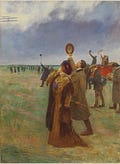Autodidacts collect ideas, lots of ideas. Thus, a person will not spend much time on the path of self-tuition before he finds himself in need of some means of organizing this dragon’s hoard of thoughts, impressions, and mental models.
As every idea, whether humble or grand, emerged at some point in time, the classic solution to this problem makes use of history. To be more specific, a person who acquires a good sense of the sequence of great events will possess an excellent means, not merely of storage and retrieval, but of connecting ideas to each other.
Books, video series, and podcasts offering historical frameworks abound. Some, like A Short History of Man, are short. A few, like the History of the World and a History of Europe, Great Battles, run for more than a hundred hours. Others, like The Western Tradition and Civilization, fall somewhere in the middle.
Because of this bounty, I recommend an approach to the enjoyment of these works that might be called the “widening gyre.” The construction of the structure starts with the shortest of the worthwhile works, progresses to those of middling length, and finishes his framework with hundred-hour programs and mighty tomes. (Of the latter, the first that comes to mind is From Dawn to Decadence.)
One advantage of the “widening gyre” is the natural progression of the project. The learner completes the rough frame before he begins to hang the dry wall. Another is the existence of companion volumes for many of the shorter programs. (Reading and listening to the same material makes a stronger impression on the mind than exclusive reliance on a single mode of engagement.)
Of the shorter “Plato to NATO” programs, some of the best proved popular forty or fifty years ago. Thus, while the audio-visual versions are often available for free, their paper-and-ink companions are both widely available and cheap as proverbial chips.




